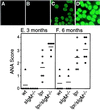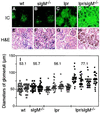Accelerated development of IgG autoantibodies and autoimmune disease in the absence of secreted IgM
- PMID: 10655505
- PMCID: PMC15562
- DOI: 10.1073/pnas.97.3.1184
Accelerated development of IgG autoantibodies and autoimmune disease in the absence of secreted IgM
Abstract
Individuals with systemic lupus erythematosus and rheumatoid arthritis are characterized by the presence of high levels of circulating IgM and IgG autoantibodies. Although IgG autoantibodies often are pathogenic, the role of IgM autoantibodies in autoimmune disease is not clear. Using mice that are unable to secrete IgM but are able to express surface IgM and IgD and to secrete other classes of immunoglobulins, we examined the effect of the absence of secreted IgM in the development of IgG autoantibodies and autoimmune disease in lupus-prone lymphoproliferative (lpr) mice. Compared with regular lpr mice, lpr mice that lack secreted IgM developed elevated levels of IgG autoantibodies to double-stranded DNA and histones and had more abundant deposits of immune complexes in the glomeruli; they also suffered more severe glomerulonephritis and succumbed to the disease at an earlier age. Similarly, the absence of secreted IgM also resulted in an accelerated development of IgG autoantibodies in normal mice. These findings suggest that secreted IgM, including IgM autoantibodies produced naturally or as part of an autoimmune response, may lessen the severity of autoimmune pathology associated with IgG autoantibodies.
Figures






References
-
- Theofilopoulos A N, Dixon F J. Adv Immunol. 1985;37:269–390. - PubMed
-
- Feldmann M, Brennan F M, Maini R N. Cell. 1996;85:307–310. - PubMed
-
- Kotzin B L. Cell. 1996;85:303–306. - PubMed
-
- Hahn B H. N Eng J Med. 1998;338:1359–1368. - PubMed
-
- Ohnishi K, Ebling F M, Mitchell B, Singh R R, Hahn B H, Tsao B P. Int Immunol. 1994;6:817–830. - PubMed
Publication types
MeSH terms
Substances
Grants and funding
LinkOut - more resources
Full Text Sources
Other Literature Sources
Medical

